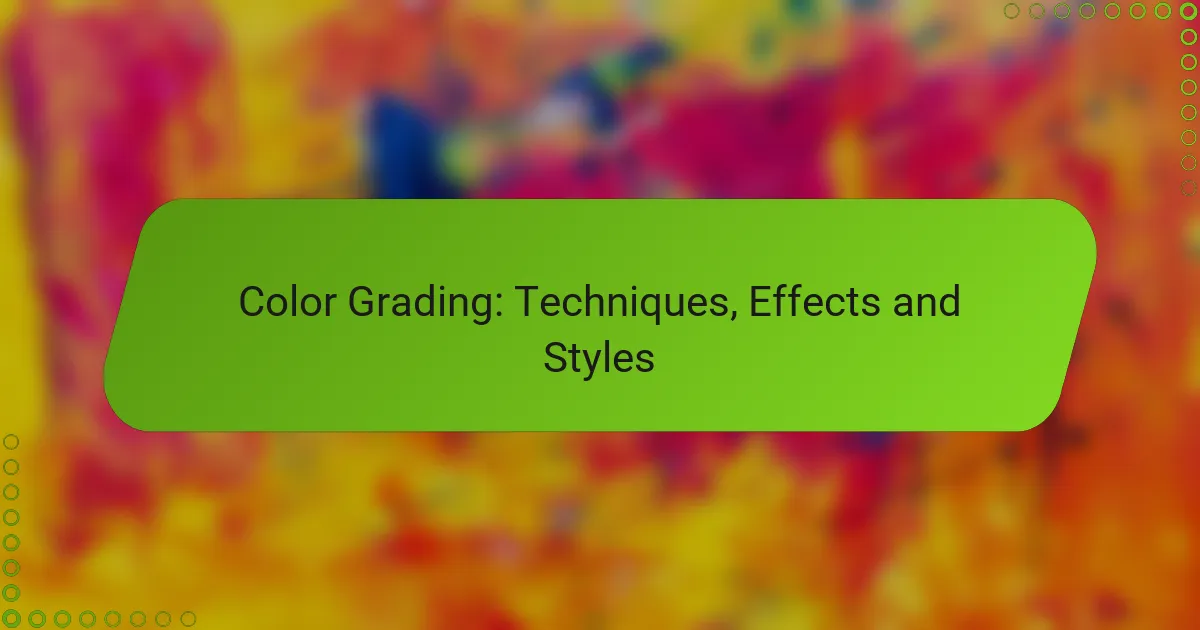Color grading is a vital process in video and photography that enhances visual storytelling by adjusting colors to create specific moods and aesthetics. By employing techniques such as primary and secondary color correction, color wheels, and LUTs, creators can manipulate hues, saturation, and contrast to evoke emotions and elevate their projects. Understanding these methods is essential for filmmakers and video editors looking to achieve impactful visuals.

What Are the Key Color Grading Techniques?
Key color grading techniques enhance the visual appeal of video and photography by adjusting colors to achieve a desired mood or aesthetic. These methods include primary and secondary color correction, the use of color wheels and curves, LUTs (Look-Up Tables), and masking and tracking.
Primary Color Correction
Primary color correction involves adjusting the overall color balance of a video or image to ensure accurate color representation. This technique typically focuses on correcting exposure, contrast, and white balance, which can significantly impact the final look.
Common adjustments include modifying the brightness and saturation levels of the primary colors: red, green, and blue. A good rule of thumb is to aim for a balanced histogram, ensuring no color is overly dominant or clipped.
Secondary Color Correction
Secondary color correction targets specific colors within an image or video to enhance or alter them without affecting the entire frame. This technique is useful for emphasizing certain elements, such as making a sky bluer or skin tones warmer.
Tools like HSL (Hue, Saturation, Lightness) sliders allow for precise adjustments. When using secondary color correction, be cautious of color shifts that may create unnatural results, and always preview changes in context.
Color Wheels and Curves
Color wheels and curves are powerful tools for manipulating color and contrast in a more nuanced way. Color wheels allow users to adjust the shadows, midtones, and highlights independently, providing greater control over the image’s overall tone.
Curves offer a graphical representation of brightness and color adjustments, enabling fine-tuning of specific tonal ranges. When using these tools, start with subtle adjustments to avoid drastic changes that can lead to an unnatural appearance.
LUTs (Look-Up Tables)
LUTs are pre-defined color grading presets that can quickly apply a specific look or style to footage. They are particularly useful for achieving a consistent aesthetic across multiple clips or projects.
When selecting a LUT, consider the source material and the desired outcome. It’s often beneficial to adjust the intensity of the LUT to ensure it complements rather than overwhelms the original footage.
Masking and Tracking
Masking and tracking are techniques used to isolate specific areas of an image for targeted color grading. Masking allows you to create shapes that define which parts of the frame will be affected by color adjustments, while tracking ensures these masks follow moving subjects.
For effective results, use feathering to soften mask edges and avoid harsh lines. When tracking, ensure the motion is smooth to maintain a natural look, as abrupt changes can draw attention to the grading rather than enhancing it.

How to Achieve Specific Color Effects?
To achieve specific color effects in your visuals, you need to understand the fundamental techniques of color grading. This involves manipulating hues, saturation, and contrast to create desired moods and aesthetics that enhance the overall storytelling of your project.
Creating a Vintage Look
To create a vintage look, focus on desaturating colors and adding a slight yellow or brown tint. This can be achieved through color wheels or LUTs (Look-Up Tables) that mimic film stock from past decades.
Consider adjusting the contrast to soften highlights and shadows, which gives a more nostalgic feel. You might also want to introduce grain or noise to replicate the texture of older films.
Enhancing Skin Tones
Enhancing skin tones requires careful adjustments to ensure they appear natural while still vibrant. Start by isolating the skin tones using masks or color selection tools, then adjust the hue and saturation to achieve a healthy look.
A common practice is to warm up the skin tones slightly while keeping the surrounding colors balanced. Avoid over-saturation, as this can lead to unnatural appearances.
Adding Cinematic Mood
To add a cinematic mood, consider using color grading techniques that emphasize shadows and highlights. A common approach is to apply a teal and orange color scheme, which contrasts cool and warm tones effectively.
Experiment with contrast and brightness to create depth, and use vignettes to draw attention to the center of the frame. This can enhance the emotional impact of the scene.

What Are Popular Color Grading Styles?
Popular color grading styles enhance the visual storytelling of films and videos by manipulating colors to evoke specific emotions or atmospheres. These styles include distinctive techniques that can significantly alter the look and feel of the footage, making them essential tools for filmmakers and video editors.
Teal and Orange Look
The teal and orange look is a widely used color grading style that contrasts warm orange tones with cool teal hues. This combination creates a striking visual appeal, often used in action films and commercials to enhance skin tones while giving the background a cooler feel.
To achieve this look, adjust the color balance to emphasize orange in highlights and teal in shadows. Be cautious not to overdo it, as excessive grading can lead to unnatural skin tones. A good rule of thumb is to maintain a balance where skin tones remain realistic while backgrounds pop.
Desaturated Colors
Desaturated colors involve reducing the intensity of hues to create a muted, understated look. This style is often employed in dramatic narratives or documentaries to convey a sense of realism or somberness.
To implement desaturation, lower the saturation levels in your editing software while maintaining contrast. Aim for a palette that feels cohesive but not overly dull. A common approach is to keep key elements slightly saturated to draw attention while allowing the rest of the scene to feel more subdued.
High Contrast
High contrast color grading emphasizes the difference between light and dark areas, resulting in a bold and dynamic visual style. This technique is effective for creating tension or highlighting specific elements within a scene.
To achieve high contrast, increase the contrast settings in your editing software while ensuring that details in both shadows and highlights are preserved. Be mindful of clipping, as losing detail can detract from the overall quality. A practical tip is to use curves to selectively enhance contrast in specific areas rather than applying a blanket adjustment.

What Tools Are Best for Color Grading?
The best tools for color grading include software that offers advanced features for color correction, manipulation, and enhancement. Popular choices among professionals are Adobe Premiere Pro, DaVinci Resolve, and Final Cut Pro, each providing unique capabilities suited for different workflows and budgets.
Adobe Premiere Pro
Adobe Premiere Pro is a versatile video editing software that integrates color grading tools seamlessly within its interface. It offers Lumetri Color, which allows users to adjust color balance, saturation, and exposure with precision.
For effective color grading in Premiere Pro, utilize the Color Wheels and Curves for nuanced adjustments. A common pitfall is over-saturation; aim for a balanced look by frequently comparing your graded footage to reference images.
DaVinci Resolve
DaVinci Resolve is renowned for its powerful color grading capabilities, making it a favorite among industry professionals. It features an advanced color panel with nodes, allowing for complex grading workflows and precise control over each element of the image.
When using DaVinci Resolve, take advantage of its color matching tools to maintain consistency across shots. Be cautious with the use of LUTs (Look-Up Tables); while they can enhance your footage, they should complement rather than overpower your original colors.
Final Cut Pro
Final Cut Pro provides an intuitive interface for color grading, featuring tools like Color Inspector and Color Board. These tools allow for easy adjustments to color, exposure, and contrast, making it user-friendly for both beginners and experienced editors.
To optimize your color grading in Final Cut Pro, regularly use the comparison viewer to check your adjustments against the original footage. Avoid excessive use of filters that can lead to unnatural results; subtlety often yields the best outcome.

What Are the Prerequisites for Color Grading?
Color grading requires a solid understanding of color theory and familiarity with editing software. These prerequisites ensure that you can effectively manipulate colors to achieve the desired visual impact in your projects.
Understanding Color Theory
Color theory is the foundation of color grading, encompassing how colors interact and influence perception. Key concepts include the color wheel, complementary colors, and color harmony, which help in creating visually appealing compositions.
When color grading, consider the emotional impact of colors. For instance, warm tones can evoke feelings of warmth and comfort, while cooler tones may convey calmness or sadness. Understanding these effects allows for more intentional color choices.
Familiarity with Editing Software
Proficiency in editing software is essential for executing color grading techniques effectively. Popular tools like Adobe Premiere Pro, DaVinci Resolve, and Final Cut Pro offer a range of features for adjusting color balance, saturation, and contrast.
Start by exploring the software’s color grading panels and tools. Familiarize yourself with functions like curves, color wheels, and LUTs (Look-Up Tables) to streamline your workflow. Regular practice will enhance your skills and confidence in applying color grading techniques.

How to Choose the Right Color Grading Style?
Selecting the appropriate color grading style involves understanding your project’s goals, the emotional tone you want to convey, and the visual narrative you aim to create. Consider the genre, audience, and the overall aesthetic to make an informed choice that enhances your work.
Assessing Project Goals
Begin by clearly defining the objectives of your project. Are you aiming for a dramatic effect, a nostalgic feel, or a vibrant and lively atmosphere? Each goal will guide your color grading choices, influencing everything from color palettes to contrast levels.
Next, evaluate the genre of your project. For instance, a horror film may benefit from cooler tones and high contrast to evoke tension, while a romantic piece might use warm hues to create intimacy. Aligning your color grading style with the genre can significantly enhance storytelling.
Lastly, consider your target audience. Different demographics may respond uniquely to color schemes. For example, children’s content often employs bright, saturated colors, while more mature audiences might prefer subdued tones. Tailoring your approach to your audience can improve engagement and emotional impact.
